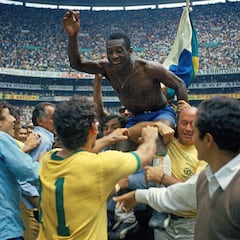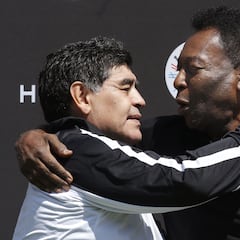When did Pelé make his debut, what teams did he play for and when did he retire?
Whether it was his debut for one of Brazil’s biggest clubs, or the World Cup he won at 17-years-old, there was no part of Pelé's career that wasn’t sensational.


As we consider the body of work, will and success that was the great Pelé's club career, join us for a trip down memory lane, as we take a look at the man known as “O Rei,” from his debut to his retirement.
From Boy to Legend: Pelé
Born on October 23rd, 1940 in Minas Gerais, Brazil, Edson Arantes do Nascimento - the man we all know today as Pelé - came into a world where he would have to overcome the struggles of poverty, before he would bless us all with his gift. Though his father, João Ramos do Nascimento actually played professional soccer himself, it was not a career that provided much to the family in the way of money. Indeed, some anecdotes even suggest that Pelé's family couldn’t afford to buy him a ball, such that he was forced to stuff socks in an attempt to create the shape of a ball, which he could then practice with. Needless to say, that little boy from the southeast of Brazil has scaled unimaginable heights since then.
Debut & Early Career with Santos
Truthfully, Pelé continued to struggle financially during his adolescent years in São Paulo, working a variety of jobs to help his family, before finally discovering his true calling on the field. Under the instruction of his father and a former national team player named Waldemar de Brito, Pelé began to mature as a player with the Bauru Athletic Club juniors. It was there, that de Brito recognized his ability and in turn recommended him for a trial with Santos FC. It didn’t take long for the team’s management to realize what they had on their hands and so, in June of 1956 the club signed Pelé. Believe it or not, it would be just three months later on September 7th, 1956, when Pelé made his senior team debut for Santos FC against Corinthians in what turned out to be a 7-1 victory. Fittingly, the future star scored a goal in his first game.
ON THIS DAY: In 1956, a 15-year-old Brazilian wonderkid called Edson Arantes do Nascimento scored on his debut for Santos.
— Squawka (@Squawka) September 7, 2019
You might know him as Pelé. pic.twitter.com/SDG8JJOIue
A Young Star on the Rise
Across his maiden season, Pelé decimated the league and by the time the curtain came down on that first year, the now 17-year-old star found himself sitting atop the scoring charts. With that, Brazil’s national team came calling and we don’t have to tell you, Pelé answered. In his first foray into international competition, he scored key goals in both the semifinal and the final match of the 1958 World Cup to win it for Brazil, including the legendary sombrero and volley combination against finalists and hosts, Sweden - see it below. To call him a superhero at this point, would have been stating the obvious. Not only was his name known throughout Brazil, but quite frankly, across the globe. The Brazilian government even honored him as a “national treasure,” which of course elevated his status at home, but it also had the clever effect of warding off courtship from foreign clubs.
😲🙌🇧🇷
— FIFA World Cup (@FIFAWorldCup) April 13, 2018
This week's @Hyundai_Global 'Anatomy of a Goal' remembers @Pele's superb technique in the 1958 #WorldCup Final against Sweden pic.twitter.com/kdevqiI7DB
Injuries Took their Toll
As is the case with any life story, things aren’t always positive and in Pelé's case, the dark moments in his path came in the form of injuries. Though Brazil would still go on to win the 1962 World Cup, Pelé would be forced to miss some of the campaign due to injury. That tournament would be followed up by a disastrous performance in 1966 which resulted in a group stage exit. An injured Pelé could only watch from the sidelines. Despite the disappointment with the national team, he continued to excel with Santos. So much so in fact, that teams began to create tactics and strategies specifically to deal with the threat he posed. Unfortunately for them, it didn’t work. In the 1964 season, the attacking midfielder scored an astonishing 60 goals, which incredibly, pales in comparison to the 101 that he scored the year after. We’re not making this up.
Pelé has the World Cups greatest ever legacy, yet he was extremely unlucky in them.
— AllThingsSeleção ™ (@SelecaoTalk) March 27, 2021
1958 - missed the first 2 games through injury
1962 - (at his peak) injured in second group game & missed the tournament
1966 - missed 2nd group game (injured) & injured again in next game. pic.twitter.com/W7BRKWRGYL
From Retirement to a Comeback
When 1970 - a World Cup year - rolled around, it was understood that Pelé had seen enough and was in fact set on retirement. Fortunately for football fans, he was convinced to give it one last go with Brazil who were heading to Mexico for the big tournament. It would be a decision that, gave us a chance to witness arguably the greatest team ever in World Cup history. During the tournament, Pelé contributed to Brazil’s eventual world championship win, with several key goals and assists. Indeed, he would be awarded the Golden Ball at the end of the tournament. For his part, Pelé would continue for one more year in the national team setup before finally saying goodbye in 1971. Just a few years later in 1974, he would say goodbye to Brazilian football altogether following his 19th season with Santos. That, however, was not a goodbye to football in its entirety.
*In case you’re not sure, the sign and caption below read: We’re not working today because we’re going to watch Pelé*
Guadajara, México, 1970.
— PELEJA (@PELEJA) November 27, 2022
“Hoje não trabalharemos porque vamos ver Pelé.” pic.twitter.com/eYLjPS9F4e
“O Rei” says Goodbye for Good
Though he had always maintained he would never play for another club aside from Santos, it was clear to see that there was still gas left in his tank when he left the club. What came next, few could have predicted. Seemingly feeling the itch, Pelé stunned the world by signing for the New York Cosmos in 1975. It was of course a move that puzzled many, as the North American Soccer League (NASL) represented a significant drop in quality where the level of play was concerned. On the other hand, it’s clear that the Santos legend had other things in mind. The fledgling league benefitted greatly from Pelé's role as an ambassador of the game. With that, ticket sales dramatically increased, while the American public which was not very familiar with the game of soccer at the time, began to take notice of the Brazilian star.
During my last ever professional game, today in 1977, the rain started. A Brazilian paper said that even the sky was crying. I knew how it felt. // Durante meu último jogo profissional, em 1977, choveu muito. Um jornalista disse que até o céu estava chorando. Eu também estava. pic.twitter.com/Mgm43ZrJrp
— Pelé (@Pele) October 1, 2018
Alas, it was not an adventure that lasted for a long time. After leading the Cosmos to a championship, Pelé finally called it quits on October 1st, 1977 in an event that was marked by an exhibition game between Santos and the Cosmos. With a sold-out crowd at Giants Stadium, which included the likes of Muhammad Ali and Bobby Moore, the Brazilian star scored a 30-yard freekick for the Cosmos in the first half, before switching to Santos for the 2nd. Interestingly, it was during that second half that the rain began to fall, which later promoted a Brazilian newspaper to run with the headline “Even The Sky Was Crying” on the very next day.
The effect of Pelé
Related stories
Aside from the immense skill that he possessed and the staggering success that it brought, there is perhaps one aspect of Pelé that stands above all others: his humility and kindness. Indeed, the manner in which he endeared himself to soccer fans the world over and even those who didn’t love the game, was something to behold. From factions involved in the Nigerian Civil War of 1969, which agreed to a 48-hour ceasefire so they watch him play an exhibition game in Lagos, to his decision to play a similar match in Lebanon in 1975 just one week before the country’s own civil war erupted, the Pelé effect was special. Yet, these are all facts, records and stories. There is no better way to describe Pelé's manner than to use the words of the man himself, which he spoke to that above mentioned crowd at Giants Stadium on the day he officially said goodbye to football:
“Love is more important than what we can take in life”

